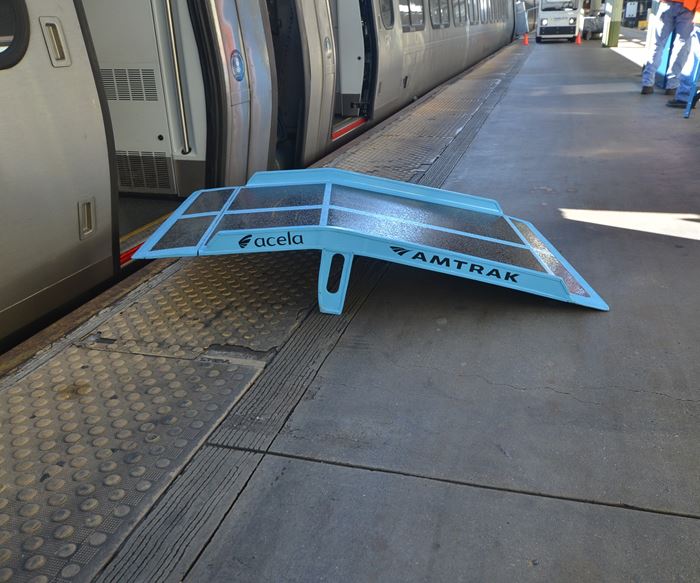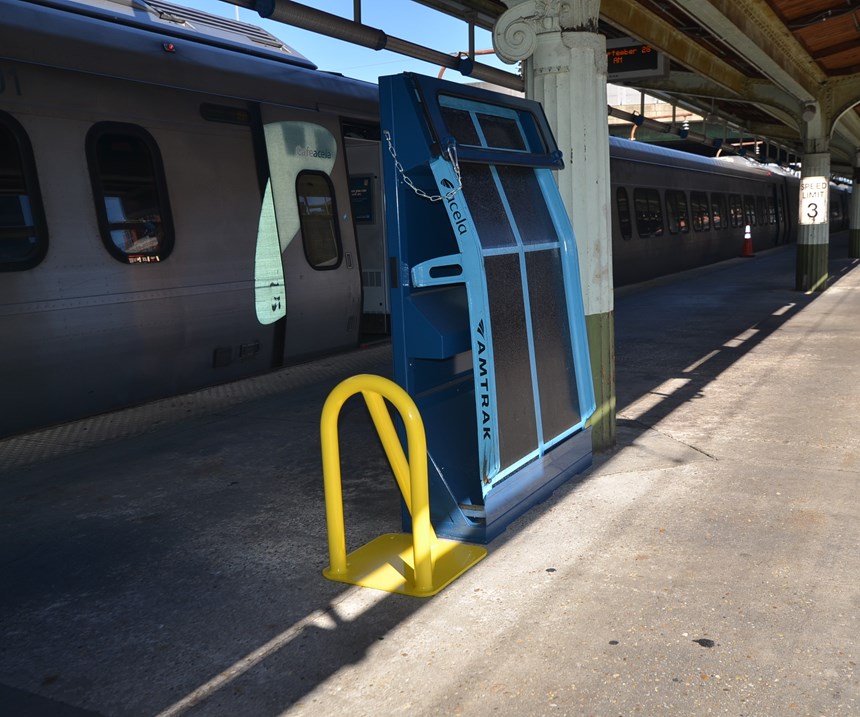Plasan to manufacture composite ramps for Amtrak
Plasan Carbon Composites meets stringent weight and strength requirements for Amtrak’s Acela rail service.
Plasan Carbon Composites (PCC, Wixom, MI, US), a supplier of carbon fiber-reinforced plastic (CFRP) components for the transportation market, announced on Jan. 5 that it has been awarded a contract to produce the first composite ramps and bridgeplates for Amtrak (National Railway Passenger Corp., Washington, DC).
The units, which are part of Amtrak’s Accessible Boarding Technologies (ABT) Program, help make it easier and more accessible for passengers with disabilities, the elderly, as well as those pushing strollers or pulling luggage to embark and disembark from trains, providing as close to independent access as possible at all available railcars along a platform. The initial order of 190 composite ramps and bridgeplates will be deployed at various Amtrak locations and on various railcars followed by further distribution throughout the Amtrak system.
Under the guidance of Gary Talbot, Amtrak program director-ADA, the company currently is in the process of redesigning and rebuilding platforms, station structures and parking lots at many stations throughout its North American network to ensure they comply with the American’s with Disabilities Act (ADA) of 1990. One area of focus is developing lighter and better-designed ABTs — specifically bridgeplates and ramps.
Between any passenger platform and the trains that pass it, a gap is left to provide safe clearance during normal train operations. Gap dimensions (defined as the horizontal and vertical distance between platform and railcar) are designed based on minimum industry standards as well as clearance requirements for the types of trains (passenger, freight, or both) operating adjacent to a platform. Platforms at stations with passenger-only trains typically have smaller gaps than those with shared-use (passenger-plus-freight) trains. Ambulatory passengers are reminded to “mind the gap” and step over the 7.6-25-cm horizontal gap and approximately 7.6-cm vertical gap between train and platform during entry/exit. At some stations, however, gaps between train cars and platforms can be even larger and that can make it difficult for passengers using wheeled mobility devices to span the gap, even when a bridgeplate (used for level boarding) or a ramp (used for uneven/bi-level boarding or for shared-use platforms) is installed. Bridgeplates and ramps are typically made of aluminum and can weigh as much as 15 kg for a small bridgeplate and 40 kg for a short ramp without handrails. Bridgeplates are stored at stations and used at passenger-only platforms, whereas ramps are stored on trains and used on shared-use platforms.
Initially, Amtrak developed its own prototype tooling and units, which were produced by RLE International (Madison Heights, MI, US), which had engineering and pre-production manufacturing help from Wahoo Composites, based in Ann Arbor, MI. The goal was to increase passenger accessibility and to reduce weight so these ABT devices were easier for employees to carry and deploy/remove. Next, Amtrak sought bids from companies thought capable of optimizing the design, as well as molding, assembling, and finishing production units. The plan required the manufacturer to produce assembled CFRP bridgeplates in two styles — Acela1 and Regional — that weighed no more than 9.1 kg each and accommodated two door-opening widths. The plan also called for production and assembly of telescoping ramps with integrated folding handrails in two styles – Superliner (with metal hooks) and Surfliner (with CFRP hooks) — that weighed no more than 25 kg each and that accommodated two attachment methods to trains.
As part of the qualification process, prototype units of bridgeplates and ramps were required to pass tests including a 363-kg service-load capacity and a 3X safety factor of 1,089-kg ultimate strength. Additionally, each item was required to be warranted by the manufacturer against defects and/or premature failure for a service period of not less than 12 months from the date of field deployment into Amtrak revenue service and to include a maintenance contract to inspect and refurbish units that might need repainting or other repairs.
Plasan was the manufacturer chosen to produce the new Amtrak carbon composite bridgeplates and ramps. Amtrak provided technical specifications for the ABT units; Plasan provided technical expertise in carbon composite manufacturing, engineering support, and finite-element analysis to optimize part strength and mass.
As designed, both bridgeplate models consist of five carbon fiber-reinforced epoxy prepreg components with honeycomb and foam cores: a base plate, two fins, and two gussets that are bonded together with a structural epoxy adhesive. Finished telescoping ramps consist of five carbon fiber/epoxy components: upper and lower carriers, a slider section and two single-piece handrails attached to the upper carrier. Additional hardware allows the handrails to open into position during use and fold back for stowage; stainless grades were used to increase corrosion resistance.
All carbon composite components will be produced via vacuum bag/autoclave cure with additional inflatable bladders used to produce the hollow handrails. After demolding, handrails will be attached to the ramp’s upper carrier via hinges. Next, both bridgeplates and ramps will be painted (either blue or yellow depending on model) and receive a scratch- and chip-resistant top coat and decals, as well as a non-slip surface, which will be added to the base. In the event units become damaged during use, Plasan will non-destructively scan them to determine if they can be repaired or need to be replaced; for units requiring minor repairs, CFRP patch kits will be used.
Related Content
Adhesives, material solutions promote end market versatility
CAMX 2023: Rudolph Bros. and Co. highlights its role as a prominent specialty chemical distributor and solutions provider with a display of high-performance adhesives, sealants, materials and more from well-known manufacturers.
Read MoreHenkel releases digital tool for end-to-end product transparency
Quick and comprehensive carbon footprint reporting for about 58,000 of Henkel’s adhesives, sealants and functional coatings has been certified by TÜV Rheinland.
Read MorePark Aerospace launches aerospace, MRO structural film adhesive
Aeroadhere FAE-350-1 is a curing epoxy formulation designed for composite, metal, honeycomb and hybrid applications.
Read MoreHeat-activated foaming core rapidly achieves net-shape 3D parts
CAMX 2024: L&L Products exhibits its InsituCore foaming core structural technology, which can be used to create foam core composites minus machining or presses, as well as the Phaster A K-700, a rapid-cure adhesive.
Read MoreRead Next
“Structured air” TPS safeguards composite structures
Powered by an 85% air/15% pure polyimide aerogel, Blueshift’s novel material system protects structures during transient thermal events from -200°C to beyond 2400°C for rockets, battery boxes and more.
Read MoreVIDEO: High-volume processing for fiberglass components
Cannon Ergos, a company specializing in high-ton presses and equipment for composites fabrication and plastics processing, displayed automotive and industrial components at CAMX 2024.
Read MoreAll-recycled, needle-punched nonwoven CFRP slashes carbon footprint of Formula 2 seat
Dallara and Tenowo collaborate to produce a race-ready Formula 2 seat using recycled carbon fiber, reducing CO2 emissions by 97.5% compared to virgin materials.
Read More




























